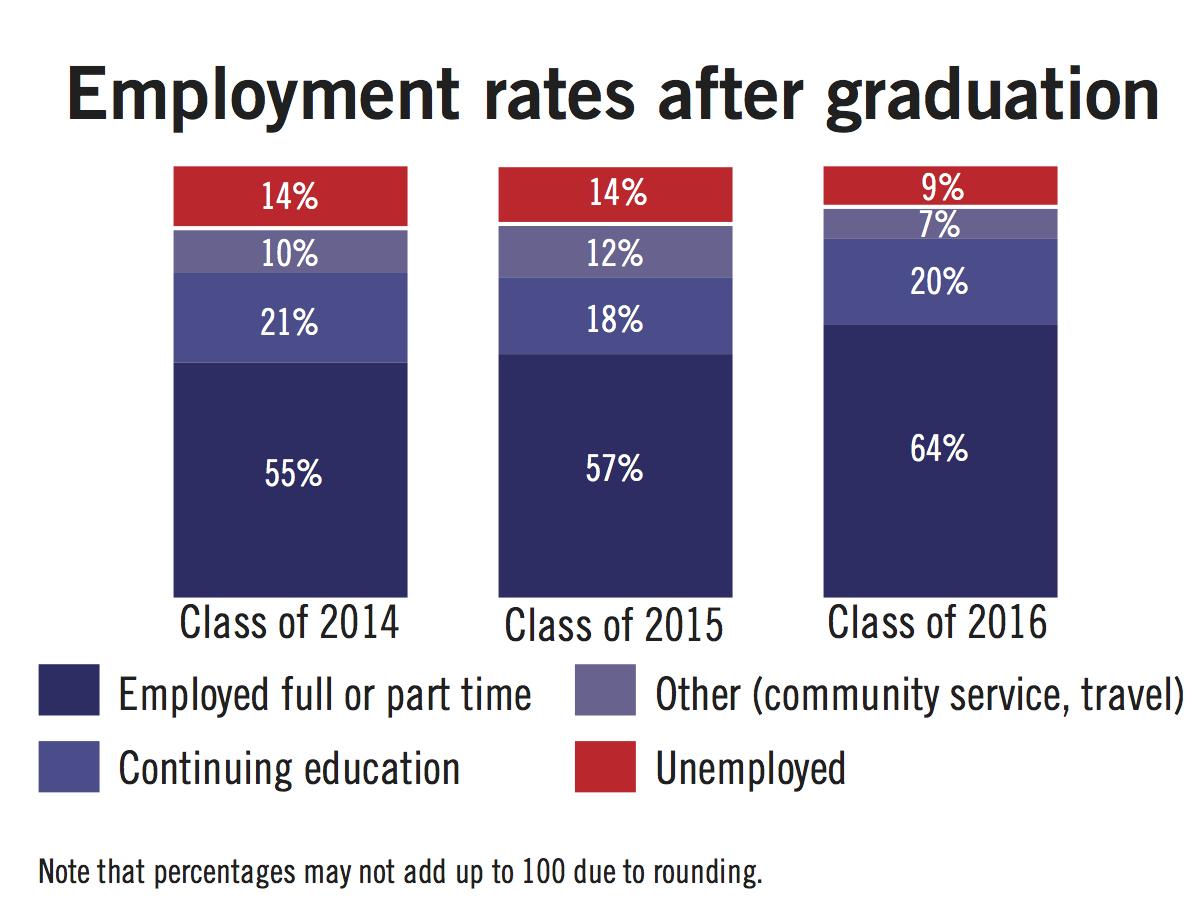Updated: April 20, 2017 at 3:19 p.m.

Yonah Bromberg-Gaber | Graphics Eidtor
Source: Office of Survey Research and Analysis
A higher percentage of GW graduates are landing jobs after graduation.
The University’s survey of recent alumni showed 64 percent were employed full or part-time within six months of graduation, an increase of seven percentage points from last year. Rachel Brown, the assistant provost for University Career Services, attributed the increase to the career center stepping up its engagement with students, but experts said there are several factors behind the results of a post-graduation survey.
The survey showed that 91 percent of the Class of 2016 was employed, in graduate school or volunteering six months after graduating last May, an increase of four percentage points from the previous year. Twenty percent of recent graduates were enrolled in graduate school this year, up from 18 percent last year.
The number of recent alumni actively seeking employment fell five percentage points to 9 percent this year.
Brown said that a number of factors led to the improvement, including the Career Services Enhancement Initiative. The initiative allowed the center to engage students early in their time at GW and offered expanded student access to career coaches, she said.
“Faculty and staff across the University and alumni are all a part of this; helping students reflect on what they are learning in and outside of the classroom and how it translates to their personal career plan and professional goals,” she said in an email.
Brown said the employment data for the Class of 2016 is the most accurate report of a graduating class yet because the University began using LinkedIn searches and faculty connections to locate recent alumni.
Eighty-five percent of recent graduates responded to the survey, the same percentage as the last two years.
Brown said alumni success in the job market is important because it strengthens GW’s alumni network.
“We are adding to the GW alumni network of lifelong learners who are applying the knowledge, skills and abilities they gained at GW to progress in their careers and impact their communities,” she said.
The Class of 2016 at Wake Forest University, a peer school of GW, has 98 percent of alumni who are employed or in graduate school, while the percentage at American University is 91.
Ed Koc, a researcher and analyst at the National Association of Colleges and Employers, said GW’s job data for this year is above the national average of 82 percent of recent graduates employed, in graduate school or volunteering within six months.
He said because the job market for recent graduates entering the workforce has not significantly improved and graduate enrollment rates have stayed relatively flat, internal GW policies were most likely the reason for the increase.
“I’ve seen trends in terms of changing resumes to reflect the capabilities of students, more cases of mock interview and video interview practices,” Koc said. “Those are some of the more effective techniques I’ve seen.”
Several large alumni donations have funded career center projects in recent years. The center has added digital mock interviews for students and started a scholarship for students with unpaid internships in 2013.
Paul Fowler, the executive director of the career center at Emory University, said data collected six months after graduation presents a “false narrative” of a university’s impact on a student.
“Graduates who are not resolved within three months of graduation begin to ‘settle’ when it comes to securing employment – thus skewing the numbers between those that have secured a definitive first-choice outcome and those that are merely finding work to pay the bills,” Fowler said in an email.
He added that historically Emory has tried to collect responses from 98 percent of its most recent graduating class to get the best quality of data.
Brian Reece, the associate director for assessment and communication at the University of Miami’s Toppel Career Center, said more specific questions about the kinds of jobs students are getting can improve the quality of data in the survey.
“There’s a lot of pressure from alumni parents or donors to show value provided to students,” Reece said. “Universities are putting a lot more resources in better data.”
This post was updated to reflect the following correction:
The Hatchet incorrectly spelt Brian Reece’s name. It is now correct. We regret this error.




